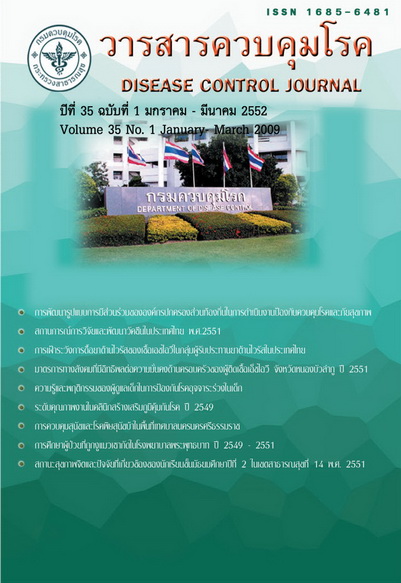Development of a Model of Participation for the Local Administrative Organization for Disease Prevention and Health Hazard Control
Keywords:
Participation, Local Administrative Organization, Prevention Disease and Health Hazardous ControlAbstract
A participatory action research was conducted to develop a participation model of disease prevention and health hazard control for local administrative organization (LAO). Knowledge management techniques, such as a knowledge sharing method, story telling, and an action review technique were applied to build a community participatory process. Three LAOs were purposively selected into the study including Tasai subdistrict administrative organization in Chiang Rai, U-mong sub-district municipal in Lumphun, and Maelai sub-district municipal in Prae. The research were conducted during October 2007 to September 2008. Interpretation of Qualitative data those were derived from during-action and after-action reviews, participant observation, and note taking were presented. Results showed that three participation models of disease prevention and health hazard control were developed by LAOs. The first was a reduction in the insecticide use in agricultural products of Tasai subdistrict administrative organization. The second was an air pollution mitigation in U-mong sub-district municipal. The third was a diabetes and hypertension prevention program by Maelai sub-district municipal. There were four steps of the model development: 1) preparation and community selection, 2) capacity building of team leader as facilitators, 3) identification of health issues and project planning and implementation by community participation process, and 4) action review and evaluation. Characteristics of community participation encompassed data provision, a model planning, and joint implementation. However, there were only community leaders and LAO leaders participating in the process. These could affect the sustainability of the program when they were no longer in the position. The LAOs in the research were selected according to their existing health policy and readiness. The results therefore could be a guide to aid other locales that had a similar setting to develop the participation model. However, more information was required, particularly in the certain community. In addition, the duration of study was also necessary for the community to have step-by-step learning and should be, if possible, in accordance with the term of the LAO's administrative team being in its position.
Downloads
References
2. รัฐธรรมนูญแห่งราชอาณาจักรไทย พุทธศักราช 2540 จาก http://www.search-thais.com /law/ratammanoon.htm. ค้นเมื่อ 20 มกรมคม 2551.
3. พันธุ์ทิพย์ รามสูตร. การวิจัยปฏิบัติงานอย่างมีส่วนร่วม. กรุงเทพฯ: พี.เอ.ลีฟวิ่ง; 2540.
4. ชัชวาลย์ ทัตศิวัช. การวิจัยเชิงปฏิบัติการแบบมีส่วนร่วม: มิติใหม่ของรูปแบบวิธีวิจัยเพื่อการพัฒนาชุมชนระดับท้องถิ่น. จาก http://gotoknow.org/file/ mhsresearch/ PAR+for+Community.doc. ค้นเมื่อ 20 พฤศจิกายน 2550.
5. สิทธิณัฐ ประพุทธนิติสาร. การวิจัยเชิงปฏิบัติการแบบมีส่วนร่วม : แนวคิดและแนวปฏิบัติ. เชียงใหม่: วนิดาเพรส; 2545.
6. สำนักงานคณะกรรมการพัฒนาระบบราชการและสถาบันเพิ่มผลผลิตแห่งชาติ. คู่มือการสร้างกิจกรรมแลกเปลี่ยนเรียนรู้. การจัดการความรู้เพื่อสนับสนุนประเด็นยุทธศาสตร์ของส่วนราชการประจำปีงบประมาณ 2550. ไม่ปรากฏแหล่งพิมพ์.
7. กรรณิการ์ พงษ์สนิท. ชวพรพรรณ จันทร์ประสิทธิ์. ประพิมพ์ พุทธิรักษ์กลุ. การมีส่วนร่วมของชุมชนในการพัฒนาคุณภาพชีวิต. มหาวิทยาลัยเชียงใหม่; 2541. ไม่ปรากฏแหล่งพิมพ์.
8. ชอบ เข็มกลัด. โกวิทย์ พวงงาม. การวิจัยปฏิบัติการอย่างมีส่วนร่วมเชิงประยุกต์. กรุงเทพฯ: สำนักพิมพ์เสมาธรรม; 2547.
9. พรทิพย์ สุประดิษฐ์ และคณะ. บทเรียนการสร้างสรรค์ชุมชนน่าอยู่. กรุงเทพฯ: โรงพิมพ์ทหารผ่านศึก; 2546.
10. Cohen, J.M. and Uphoff, N.Rural. อ้างใน ถวิลวดี บุรีกุล. การมีส่วนร่วม : แนวคิด ทฤษฎีและกระบวนการ. กรุงเทพ: บริษัทพาณิชพระนคร (2535)จำกัด; 2551.
11. ถวิลวดี บุรีกุล. การมีส่วนร่วม : แนวคิด ทฤษฎีและกระบวนการ. กรุงเทพฯ: บริษัทพาณิชพระนคร(2535) จำกัด; 2551.
Downloads
Published
How to Cite
Issue
Section
License
Articles published in the Disease Control Journal are considered as academic work, research or analysis of the personal opinion of the authors, not the opinion of the Thailand Department of Disease Control or editorial team. The authors must be responsible for their articles.






